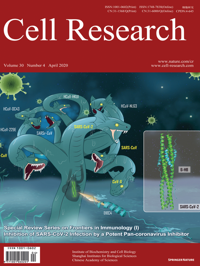
Volume 30, No 4, Apr 2020
ISSN: 1001-0602
EISSN: 1748-7838 2018
impact factor 17.848*
(Clarivate Analytics, 2019)
Volume 30 Issue 4, April 2020: 285-299 | Open Access
REVIEW ARTICLE
The yin and yang of co-inhibitory receptors: toward anti-tumor immunity without autoimmunity
Alexandra Schnell1, Lloyd Bod 1, Asaf Madi2 and Vijay K. Kuchroo 1,3
1Evergrande Center for Immunologic Diseases, Harvard Medical School and Brigham and Women’s Hospital, Boston, MA 02115, USA; 2Department of Pathology, Sackler Faculty of
Medicine, Tel-Aviv University, Tel Aviv-Yafo, Israel and 3Klarman Cell Observatory, Broad Institute of MIT and Harvard, Cambridge, MA 02142, USA
Correspondence: Vijay K. Kuchroo (vkuchroo@evergrande.hms.harvard.edu)
Co-inhibitory receptors are important regulators of T-cell function that define the balance between tolerance and autoimmunity. The immune regulatory function of co-inhibitory receptors, including CTLA-4, PD-1, TIM-3, TIGIT, and LAG-3, was first discovered in the setting of autoimmune disease models, in which their blockade or deficiency resulted in induction or exacerbation of the disease. Later on, co-inhibitory receptors on lymphocytes have also been found to influence outcomes in tumor and chronic viral infection settings. These receptors suppress T-cell function in the tumor microenvironment (TME), thereby making the T cells dysfunctional. Based on this observation, blockade of co-inhibitory receptors (also known as checkpoint molecules) has emerged as a successful treatment option for a number of human cancers. However, severe autoimmune-like side effects limit the use of therapeutics that block individual or combinations of co-inhibitory receptors for cancer treatment. In this review we provide an overview of the role of co-inhibitory receptors in autoimmunity and anti-tumor immunity. We then discuss current approaches and future directions to leverage our knowledge of co-inhibitory receptors to target them in tumor immunity without inducing autoimmunity.
Cell Research (2006) 16:741. doi:10.1038/sj.cr.7310094; published online 14 Sep 2006
FULL TEXT | PDF
Browse 975


